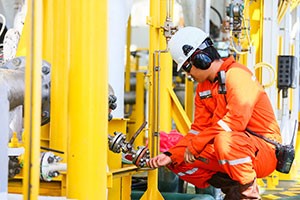Three Overlooked Hazards in Oil and Gas Extraction

Oil and gas extraction (OGE) is one of the most dangerous industries for workers. The Centers for Disease Control and Prevention (CDC) reports that occupational fatality rates in this field are consistently higher than those in other industries. While many of these hazards are well known, such as toxic, flammable, and explosive materials, three less obvious sources of harm disproportionately affect OGE employees.
1. Noise Level
Oil and gas extraction is a loud process, with workers regularly exposed to harmful levels of noise. The CDC reports that about 61% of employees in mining, oil, and gas extraction (MOG) have been exposed to harmful levels of noise. About 14% of those OGE workers have a hearing impairment.
Just about every piece of equipment used at an oil well, from compressors to pump trucks, exceeds the 85 dB line at which the Occupational Safety and Health Administration (OSHA) requires a hearing conservation program. A study of Northern Colorado oil and gas sites established that even at 350 ft from a noise source, “all drilling, hydraulic fracturing, and completion sites exceeded 65 dBC,” above the 55 dB allowed for residential zones. Imagine how loud it must be for workers within the site!
Regular hearing tests and monitoring for all workers exposed to harmful noise are necessary, as well as employer-provided hearing protection. OSHA mandates this include at least one variety of ear plug and one variety of ear muff. This would help to prevent some hearing loss, but 28% of noise-exposed MOG workers report that they don’t wear hearing protection. This is where regular compliance checks and training can assist.
2. Temperature
Extreme temperatures are a factor in many outdoor jobs, but OGE operations are especially common in high-heat climates. Conditions routinely surpass 100°F, which are even more dangerous for newer workers who haven’t been acclimatized to heat. OSHA identified 50 heat-related hospitalizations from OGE activities, including 9 deaths, from 2015-2021.
Why is heat stress a risk? Excessive time in hot conditions, especially without adequate water and breaks, can prevent your body from dissipating heat. Potentially dangerous illnesses like heat exhaustion, fainting, and heat stroke can result. Acclimatization practices for new employees and general heat stress training, including workers trained to monitor conditions, can help prevent heat illnesses. Work schedules with water breaks and rest in shaded environments are vital for temperature safety. Head and face cooling products, as well as electrolyte drinks, can also protect workers.
3. Gravity
Fall-related accidents are another common OGE workplace hazard. OSHA reports that oil and gas extraction has the highest fall rates of any industry! The reasons for this excessive fall-injury rate are numerous: ladders and walkways on oil rigs are extremely high and can be slippery, while workers exhausted from shifts lasting up to 16 hours are more prone to error. With 148.9 severe injuries per 100,000 workers, fall safety must be addressed.
In addition, dropped objects can cause serious harm for oil and gas workers. Lifting operations and installing machinery or tooling at significant heights are common tasks in OGE and can involve heavy equipment like piping. Even the vibration from drilling activities can be enough to loosen a poorly secured item.
Regardless of the stability of a walkway or ladder, fall protection equipment is paramount to worker safety. Important safety gear includes harnesses, anchors and anchorage connectors, lanyards, and lifelines.



